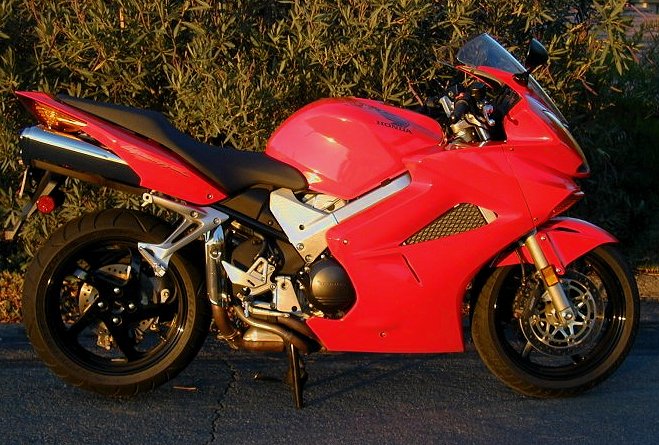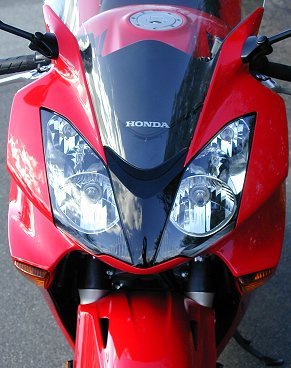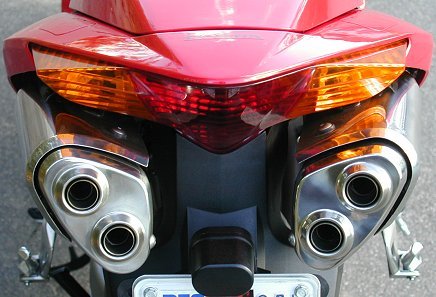
This is a brief summary of our initial impressions of Honda’s new 2002 Interceptor. We will follow this up with a more in-depth review in Part Two within a couple of weeks. Take a look at several photos we previously published of a European model Interceptor (identical, except for color) on September 10, 2001.
When I think about Honda and the bikes they manufacture, it is apparent to me that two models in Honda’s line-up are particularly special to Honda. They are not just another model that Honda wants to design and engineer well (and I am not saying Honda doesn’t have this goal with all of its models), but they have become special symbols of corporate pride. The Gold Wing is one of these bikes, and the VFR Interceptor is another one.
Long known simply as the “VFR”, and displacing 750cc until four years ago (at which time it became 781cc), the model has evolved towards the simple “Interceptor” name tag. The basic recipe has always been the same, however.
With a V-four layout, the engine in the Interceptor has always had a relatively close relationship to Honda’s racing efforts. Prior to the introduction of Honda’s RC51 V-twin superbike, Honda campaigned the RC45 V-four, 750cc superbike worldwide. A bike American John Kocinsky took to the World Superbike championship.

Although evolved from its racing roots into a sport tourer, the Interceptor has remained a showcase of Honda engineering muscle and design. With its single-sided swingarm (something the Interceptor featured even before Ducati’s 916 superbike), relatively complex V-four layout, and gear-driven cams (only now replaced by a chain-drive mechanism in the 2002 Interceptor), the Interceptor eventually received fuel injection and a linked braking system in 1998. This year, an optional ABS braking system is also available.
With all of the dramatic new models announced by Honda this year, the new Interceptor could have been dismissed as a mild cosmetic update, without significant changes to its performance and handling levels. With roughly the same peak horsepower and the same displacement (781cc), and perhaps a few more pounds of weight, some Interceptor fans were frankly disappointed. The styling of the new Interceptor, although retaining some family resemblance, is a bit bold for a Honda — with the front-end of the bike being somewhat controversial.
Like any bike, however, you can’t just read about it and look at pictures. You have to ride it and live with it. We have just begun that process.
Aside from styling, and the previously-mentioned chain-driven cams, the big news with the new model is the introduction of the VTEC engine. VTEC is a trademarked acronym used for years in connection with Honda automobile engines, and typically describing variable valve timing (such as shifting cam lobes — where the lobe shift occurs at a fixed rpm level). In the new Interceptor, however, VTEC refers to the ability of the engine to operate on two valves per cylinder or four valves per cylinder depending on rpm range. Below 7000 rpm, the Interceptor runs on two valves per cylinder. Above 7000 rpm, the Interceptor runs on four valves per cylinder.
The purpose of the VTEC system on the Interceptor, of course, is a broadening of the power curve. Operation on two valves per cylinder at lower rpm levels increases power and torque, while operation on four valves per cylinder at higher rpm levels increases horsepower and torque. Most engines must be tuned to compromise power at one (or both) extremes of the rpm range. With VTEC, the Interceptor does not have to accept this compromise.
We did a thorough ride review of the 2001 Interceptor less than a year ago, and we are very familiar with that bike. Last year’s Interceptor was an excellent machine, but our first impressions of this year’s bike indicate significant improvements.
First, and foremost, the VTEC engine is very impressive. The Interceptor has always been a fast bike (roughly, 11 seconds flat in the quarter mile), but the motor had become slightly peaky as Honda tried to squeeze higher peak horsepower out of limited displacement. The new VTEC engine has a very broad spread of torque — noticeably broader than last year’s bike. Moreover, the noise this motor makes is fantastic.

I thought I would miss the unique sound of the gear drive, when Honda announced the new machine would have chain-drive cams. The gear drive noise certainly lent an appealing character to the old bike. I was delighted to find out that the sound emitted by the new Interceptor, particularly, as the additional valves come into play at 7000 rpm, is much better than last year’s bike. Although the exhaust note is relatively quiet, the induction noise is very noticeable to the rider and is, quite simply, very entertaining music. Those of you who have driven a Honda automobile with a DOHC VTEC engine, and an open intake, can begin to appreciate (but not fully appreciate) what I am talking about.
The handling of the new Interceptor also is improved over last year’s bike. Frankly, the suspension is so spot-on I cannot think of a criticism at this point. There is a significantly stiffer feel from the new suspension versus last year’s bike, however, at the same time, the bump absorption is better. This sounds like a contradiction in terms, but Honda has pulled it off with incredible suspension tuning. Again, an analogy to automobiles is appropriate, where BMW seems to achieve the same suspension “magic” we are talking about here, i.e., firm, sure-footed control combined with supple bump absorption. The suspension is flat brilliant on this bike.
The stiffer suspension lends itself to more confident and spirited riding, as you might expect.
I have already said too much about the new Interceptor in an article I intended to be a short, succinct “Part One”, so I better stop here. Let me end by saying that we are looking forward to more seat time on the new Interceptor and, at this point, Honda appears to have taken a significant step forward from the already-excellent 2001 model. Stay tuned for Part Two.





